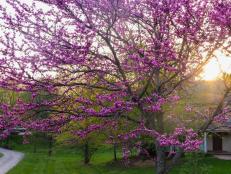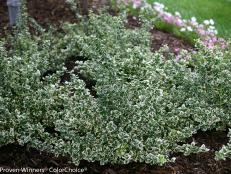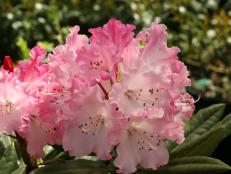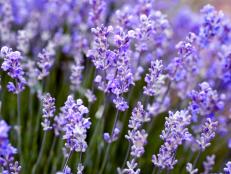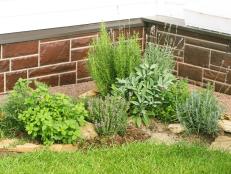How to Choose, Plant and Grow Junipers
Learn all about the various types of junipers available for landscaping, plus how to plant, prune and troubleshoot, and what varieties to choose for your home.
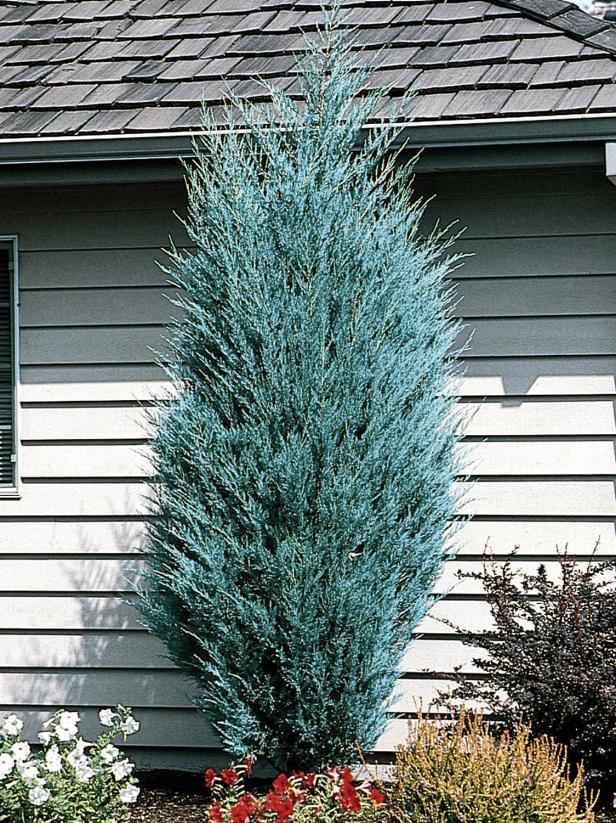
A narrow vertical accent for the garden, upright 'Medora' juniper tolerates seacoast conditions as well as drought.

Junipers are some of the most popular landscape plants, and why shouldn’t they be? These tough plants can be found growing all across the planet, often in the most desolate, rocky, windswept spots. With more than 50 individual species (13 of which are native to North America) and many more cultivated varieties that include trees, shrubs and creepers, there truly is a juniper for every garden.
When it comes to diversity, Juniperus is widely regarded as the most biologically diverse genus of needle evergreens. From sandy dunes on windswept beaches, to high above the timberline, sunbaked deserts, and even some boggy situations, chances are that if an environment sustains plant life, you’ll find a species of juniper in the mix. This biological diversity translates to amazing adaptability in the landscape, with selections available for almost any climate and landscape function.
Botanical Name: Juniperus spp.
Common Name: Juniper
Light Needs: Full sun, although some species and varieties tolerate shade
Hardiness Zones: Varies widely by species; there is a juniper for every climate
Height & Width: Differs by species
Growth Rate: Slow to medium
The evergreen foliage of junipers can grow either as sharp needles or soft, flat scales. Many species will be covered in needles in youth, extending to longer whiplike shoots that soften to flat scales. In fact, you may even notice needles, whip shoots, and scale-like growth all on one tree. Foliage color varies between and within species, and includes many shades of green, gold and even blue.
Juniper “berries” are not actually true botanical fruit at all — they are technically fleshy cones. Junipers produce separate male and female cones. The male cones are often mustard yellow and shed copious amounts of allergy-inducing pollen, while the female cones develop into powder-blue berries. While some junipers may have both male and female cones on the same plant, most junipers will only produce male or female cones. Some varieties on the market are strictly male or female, and that information is usually noted on the plant label.
Junipers have attractive peeling bark that can vary between species. Some junipers, like the Eastern redcedar (J. virginiana) have red-gray trunks with fibrous bark that will exfoliate from the tree in long strips. Others, like common juniper (J. communis) can have shaggy bark that exfoliates in large, papery strips. Alligator juniper (J. deppeana) has attractive, cross-hatched bark that looks like alligator scales.
The diversity within the genus Juniperus is staggering, and there are entire books that describe the characteristics of junipers from across the world. Below is a selection of junipers you may come across, either in parks and nature preserves or in gardens and plant nurseries.
14 Common Juniper Species
Ashe juniper (J. ashei) will become a small tree, usually around 10’ tall with a broad, spreading habit, although it can grow up to 25’ x 25’. This native species is naturally found growing in northeastern Mexico north to southern Missouri, with most of the population concentrated in central Texas. Hardy in zones 6 to 9.
California juniper (J. californica) is native to the Southwest with most of its population contained in the state of California. This shrubby tree usually grows between 10-15 feet tall, although given the right conditions it can eventually reach roughly 40’ x 50’. California juniper can be used as a hedge, in containers, and for bonsai. Hardy in zones 8 to 10.
Chinese juniper (J. chinensis) is a popular landscape species with many cultivated varieties (see below). Although the straight species can grow up to 60 feet tall and 20 feet wide, many Juniperus chinensis varieties are much more compact. Hardy in zones 4 to 9
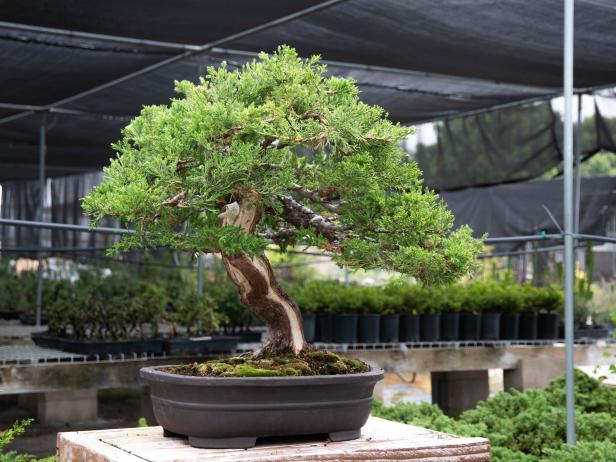
This Chinese juniper (Juniperus Chinensis prostrata) has been carefully shaped into a show-worthy bonsai.
Common juniper (J. communis) has an extensive range, and is the only species of tree that has a native distribution that spans both the eastern and western hemispheres. Closely related populations of the species are naturally found growing across North America, Greenland, and much of Europe and Asia Minor. Although common juniper has excellent ornamental value, it is also used agriculturally as a flavoring in spirits. Its berries give gin its characteristic taste. Hardy in zones 2 to 6(7).
Shore juniper (J. conferta) is a low growing species that is widely used as a salt and drought tolerant groundcover. This tough-as-nails plant can handle just about any conditions except poorly drained soil and can be grown in rock gardens, large containers, by roadsides, as a groundcover, and even on sand dunes. Plants usually grow between 1 and 2 feet tall and 9 feet wide and can be clipped to maintain lower growth. In fact, this species handles trimming so well that it can be used for bonsai too. Hardy in zones (5)6 to 9.
Alligator juniper (J. deppeana) is native to the American Southwest, including parts of Arizona, New Mexico, Texas and Mexico. There are several naturally occurring varieties of alligator juniper, some of which have long, furrowed strips of bark and others that have especially attractive checkerboard patterned bark that looks like alligator scales. Many of the cultivated varieties of this species will have blocky, scaley bark. In its natural environment, alligator juniper tends to form 10- to 20-foot-tall bushes, although it is capable of growing to heights greater than 50 feet. This species is hardy to zones (6)7 to 9 so long as it is grown in full sun and well-drained soil.
Creeping juniper (J. horizontalis) is a low-growing native to cool regions in the American Northeast, from British Columbia south to Massachusetts and west to Montana. Creeping juniper is a versatile plant that thrives in a variety of conditions in its natural range where it can be found growing over sea cliffs, rocky hills, and swamps. This species is one of the most popular groundcover junipers with many varieties on the market. Grows between 1 and 2 feet tall and up to 8 feet wide. Hardy in zones 4 to 9.
Western juniper (J. occidentalis) is endemic to the Sierra Nevada region of northern California, Oregon, Washington and Nevada, where it usually grows on mountain slopes and dry rocky foothills. Trees typically grow between 40 and 50 feet tall, although there are much larger 90-foot specimens in the northern part of the range. Hardy to zone 4.
Utah juniper (J. osteosperma) is native from the mountains of southern Idaho and Wyoming through Utah and south to Arizona and eastern California. Visitors to the Grand Canyon may notice windswept Utah junipers growing from craigs, crevices, and ledges down the canyon slopes. In nature, these stunted, gnarled, and weathered trees are rarely more than 20 feet tall, but can grow to be hundreds of years old. Utah juniper is hardy in zones 3 to 9.
Pfitzer juniper (J. x pfitzeriana) is the name of a group of hybrids between Chinese and Savin junipers. Pfitzer juniper usually grows as a large shrub with a broad, spreading habit, maturing to 10’ x 25’, although there are more compact varieties on the market. Pfitzer hybrids were once incredibly popular as foundation plants, but have fallen out of favor due to overuse. Hardy in zones 4 to 9.
Japanese creeping juniper (J. procumbens) is an excellent groundcover — especially for dry spots like roadsides and rock gardens. This low-growing species usually reaches somewhere between 1’ and 2’ in height with a span of up to 15’. Creeping juniper is also a popular species for bonsai. Hardy in zones 4 to 9
Savin juniper (J. sabina) is a fairly stiff, upright shrub with a vase-like habit. There are many Savin varieties that have been selected for foliage and form, with some excellent groundcovers too. This species does well in cooler climates and will languish in the heat of the south. Savin juniper typically grows to 6’ x 10’ and is hardy in zones 3 to 7.
Rocky Mountain juniper (J. scopulorum) is native to western North America from the eastern foothills of the Rocky Mountains in Alberta, Canada south to northern Mexico. The Rocky Mountain juniper is an extremely long-lived tree, with gnarled ancient specimens (like the Jardine juniper in Utah) that are estimated to be more than 1500 years old. This species is commonly used in the Midwest and Rocky Mountain regions for hedging and foundation plants. Given the right conditions, Rocky Mountain juniper can grow up to 40’ x 15’, although there are many more compact and narrow selections available on the market. Although this species is hardy in zones 3 to 7, it does not perform well in the humidity of the Southeast.
Eastern redcedar (J. virginiana) is a familiar tree for East Coast residents, with a native range that spans from Maine and southern Ontario south to Florida and central Texas. This species is most often seen growing along the side of the interstate, colonizing abandoned pastures, and growing along fence lines where birds that fed on the redcedar fruits happened to drop a few seeds while they rested on the rail or wire. In fact, thanks to our feathered friends, folks who garden below a utility line may find that Eastern redcedar seedlings will crop up in a straight row below the power line. Although this persistent species grows happily without the help of gardeners, there are a few eye-catching ornamental varieties that would be right at home in a cultivated landscape. Although mature specimens can grow up to 50’ x 20’, this species will tolerate hedging and even topiary, and varieties may be much more narrow or compact. Hardy in zones 3 to 9.
How to Use Junipers in Your Landscape
Depending on the variety, junipers make outstanding screens, hedges, foundation plants, groundcovers and specimen trees. Junipers grow especially well in well drained, sunny locations. Although some selections can be grown in full shade, most junipers will become more open and leggier if they don’t get enough sun. The only spot where a juniper won’t be happy is in poorly drained, boggy conditions.
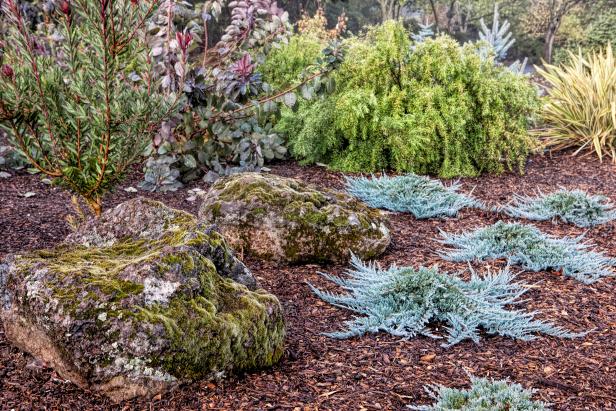
Image courtesy of courtesy Janice LeCocq
A creeping juniper, 'Blue Chip' is a low-growing, spreading evergreen with spiky, blue foliage. Like most junipers, 'Blue Chip' will not tolerate wet soil.
Junipers thrive in the most difficult situations, including sandy soils, alkaline conditions and windswept sites. Some species will even tolerate salty roadside and seaside situations. New plants need regular water during the first season, but once they’re established, they will tolerate drought extremely well. Junipers don’t need heavy fertilization or frequent irrigation to perform their best. In fact, being too generous with water and nutrients may diminish the appearance of some varieties that have been bred for foliage and form, causing tightly columnar varieties to broaden or bright blue selections to become greener.
Juniper Plus Apple
Are you growing an apple tree? Junipers are a host for the cedar apple rust fungus. Although cedar apple rust won’t cause much harm to junipers, it can be devastating to apples and other susceptible crops, causing premature leaf drop and ruining fruit. Simply plant junipers at least 500 feet from apples and their relatives to stop this fungus in its tracks.
How to Plant Juniper
Junipers are usually planted from nursery-grown containers, although larger specimens may be available as ball-and-burlap plants. Dig a hole roughly 1.5 times the width and the same depth as the pot.
Gently remove the plant from its pot. Check the outside and bottom of the root ball for circling roots. Use a sharp spade, planting knife, or hand saw to completely sever all circling roots from the outside of the root ball. This may seem drastic, but total removal is the only way to prevent these small circling roots from developing into girdling roots that will eventually kill the plant.
Next, find the root flare by gently removing some of the potting soil from the top of the root ball. Nurseries tend to plant trees a little deeply in their containers to prevent them from blowing over in the field. Carefully scoop away the soil until you find the first woody root that comes away from the stem.
Gently place the juniper root ball in the hole, adjusting to be sure that the root-shoot junction is level with the soil line. Backfill around the roots with the native soil that was excavated from the hole. Give the plant a good drink, then spread a layer of weed suppressing mulch on top of the soil.
Branching Out: A Guide to Conifers
Learn how to incorporate these evergreens into your landscape and browse beautiful conifer varieties through the lens of Jan LeCocq.
Juniper Care
Pruning and Hedging
Junipers tolerate pruning extremely well and are excellent candidates for hedging, topiary and even bonsai. However, these tough trees won’t forgive heavy-handed pruning. Before trimming a juniper, it’s important to begin by identifying the “dead zone” and avoid cutting into it.
The dead zone is the area inside the canopy of the shrub where there is no green growth. It’s totally healthy and perfectly natural for junipers to develop dead zones. When light isn’t able to penetrate to the inside of the shrub, the juniper responds by focusing its energy on growing outward and shedding its inner foliage. Even if the dead zone is exposed to light by severe pruning, the juniper won’t be able to generate new growth, and the result will be a large, dead spot.
If a juniper has outgrown its space and cutting back will expose the dead zone, remove the lower limbs to raise the canopy. This will transform a large, overgrown juniper shrub into an attractive small tree. Cut the branches all the way back to expose the peeling bark and interesting (and sometimes slightly contorted) trunk.
Health Issues
Junipers are susceptible to many pest and disease problems, including bagworms, aphids, midges, scale, webworms, mites, cedar-apple rust, wilt, twig blight and root rot. The symptoms for many of these problems can be very similar to the untrained eye and usually include some form of foliage browning out or branches dying back. If you suspect that your juniper has a health problem, call your local county extension service for help identifying the problem and finding a solution. The best way to prevent these health issues is to make sure that your juniper plants are growing in full sun (unless it is a shade tolerant variety) with plenty of drainage.
Popular Juniper Varieties
There are a multitude of Juniperus varieties available from local garden centers and specialty nurseries. A few popular ones are described below.
Groundcover and Low-Growing Junipers
- J. horizontalis ‘Wiltonii’ – striking silvery blue needles that turn purple in winter cold; this variety is female and will produce light blue berries; performs well in southern heat; grows up to 6” x 8’
- J. x pfitzeriana ‘Compacta’ – a low growing, spreading shrub that usually grows up to 18” x 6’; attractive gray-green foliage
- J. procumbens ‘Greenmound’ – produces a soft green undulating mat of growth; grows to 8” x 6’
- J. procumbens ‘Nana’ – this dwarf form tends to mound upon itself, resulting in a mounding habit; an excellent spreader that can grow to 2’ x 12’ with time
- J. squamata ‘Blue Star’ – dramatic blue foliage stands out in the landscape; this variety grows low and slow, eventually reaching 3’ x 4’; languishes in humid environments
Narrow Selections
- J. chinensis ‘Spartan’ – excellent narrow, columnar or slightly cone shaped habit; usually grows to 20’ x 4’, but can be a bit shorter and wider given environmental conditions
- J. communis ‘Pencil Point’ – a fantastic juniper for narrow spaces; this slow growing species usually grows to 6’ x 10”, although it may eventually mature to more than 10’ x 2’
- J. scopulorum ‘Moonglow’ – attractive blue color on a tightly conical tree; matures to 20’ x 5’
- J. scopulorum ‘Skyrocket’ – one of the narrowest columnar junipers available; grows to 15’ tall and only 2’ wide
- J. virginiana ‘Brodie’ – a tightly columnar form that grows up to 25’ x 6’; new summer growth is soft green, fading to sage in the winter; a female variety that will produce attractive berries rather than allergy-inducing pollen; poor root system makes this variety more susceptible to wind damage
- J. virginiana ‘Taylor’ – this narrow form is an excellent alternative to Italian cypress; silvery blue-green foliage that may bronze in the winter; grows up to 20’ x 4’
Hedges, Screens and Foundation Plants
- J. chinensis ‘Blue point’ – excellent blue foliage and teardrop shape habit; often used for screen plantings; avoid hedging to preserve attractive pyramidal habit; allow plenty of space between plants; may grow up to 15’ x 9’
- J. chinensis ‘Angelica Blue’ – beautiful blue needles on a spreading shrub; grows to 5’ x 10’
- J. x pfitzeriana ‘Aurea Improved’ – lacy golden foliage on a more compact shrub than traditional Gold Coast juniper; grows up to 3’ x 4’
Junipers That “Wow”
- J. chinensis ‘Kaizuka’– Hollywood juniper; unusual twisting branches definitely make this a statement tree; blue and variegated selections available; matures up to 30’ in height
- J. chinensis ‘Shimpaku’ – more commonly grown for bonsai than as a landscape plant; takes well to the severe trimming and root pruning involved in maintaining a bonsai plant; gray-green foliage with flaking bark
- J. deppeana ‘McFetters’ – a selection with exceptionally blue color; attractive cross-hatched alligator bark pattern; grows quickly – up to 1.5 feet per year
- J. scopulorum ‘Tolleson’s Weeping Juniper’ – excellent weeping form with beautiful cascading branches; very adaptable and can be grown in southern heat and northern cold; grows up to 20’ x 12’
- J. virginiana ‘Pendula’ – graceful weeping habit on a native Eastern redcedar; female selection with powder blue berries; ultimate height will depend on nursery practices, with some specimens growing up to 45’ tall and others only reaching 5’ in height

.-Battle-on-the-Beach-courtesy-of-HGTV.-.jpg.rend.hgtvcom.196.196.suffix/1714761529029.jpeg)





